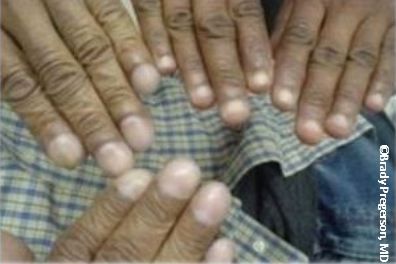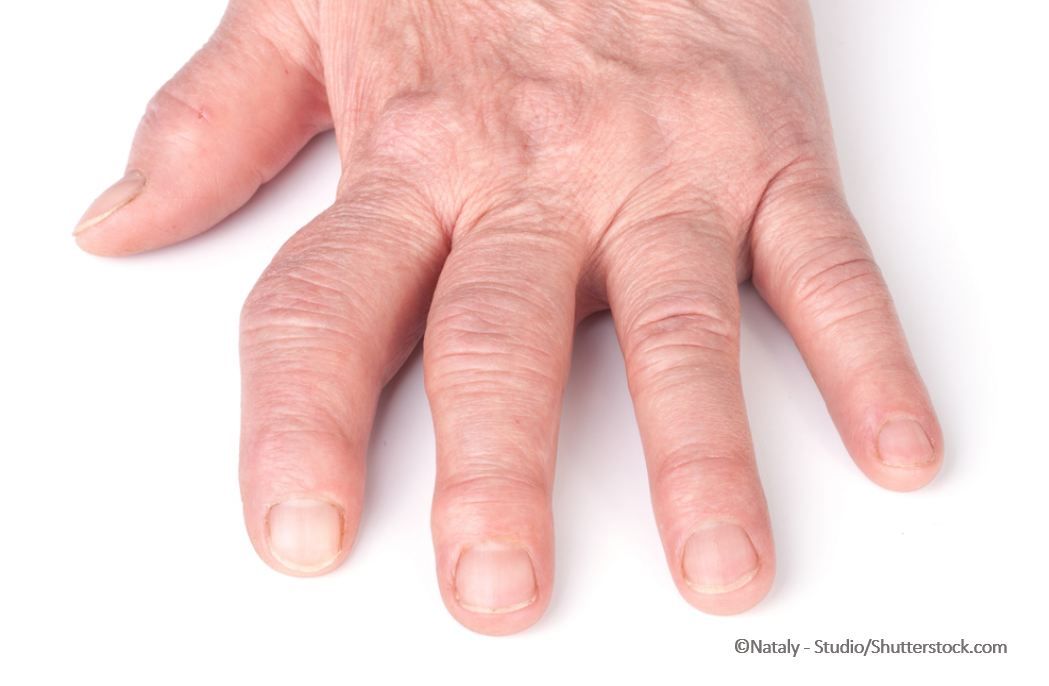A Primary Care Approach to Interstitial Lung Disease
A pulmonologist describes an approach to guide the primary care clinician faced with a patient in whom interstitial lung disease is suspected.
Figure 1. (Please click to enlarge)

Figure 2. (Please click to enlarge)

The diagnosis of interstitial lung disease (ILD) can be a daunting task. With hundreds of possibilities for diagnosis-and a confusing classification scheme that seems to keep changing-it is not surprising that many specialists and primary care clinicians are uncomfortable when they see a patient in whom they suspect ILD. Studies suggest that many patients wait years after symptoms develop and see multiple physicians before they receive a proper diagnosis.
This review is not meant to be all encompassing or particularly scholarly. Rather, it describes an approach to guide the primary care clinician when faced with a patient with possible ILD.
When should I suspect ILD?
Patients with the insidious onset of chronic cough and worsening dyspnea should set off the alarm for possible ILD. Of course, common entities such as COPD and CHF can also present with those symptoms. Here are 3 items that might clue you in that ILD is a stronger possibility.
- Crackles: Listen closely for crackles. I have gotten several referrals from primary care doctors this year and this was the only sign that the patient had fibrosis. Of course, CHF also can present with crackles, but this can easily be distinguished ILD with appropriate studies, such as a BNP or 2D-echo.
- Desaturation: I believe every clinician should have an oximeter in the office. They can be purchased for as little as $12.95 on Amazon! Patients with ILD typically will desaturate with minimal exercise, more so than with CHF or COPD. Walk them around the office and observe.
- Examine the hands: Look for evidence of arthritis, clubbing (Figure 1), vasculitis, other systemic conditions that might clue you into a particular systemic disease associated with ILD. (See section on Autoimmune Disease for more information.)
What should I do next if I suspect ILD?
Get full pulmonary function testing and order a high-resolution CT of the chest. Unfortunately, different CT facilities may interpret that order differently. Ideally, the facility will do thin cuts (1.5mm or less), prone and supine views, inspiratory and expiratory views, and sagittal and coronal reconstruction.
What should I do to determine the type of ILD?
At this point, it would be perfectly ok to refer the patient to your friendly neighborhood pulmonologist-preferably one with a special interest in ILD. But if you want to go further, the next step is to determine if there is a known cause or association to the ILD, or is it idiopathic.
Here are the five major categories of known cause:
1. Medications or toxins
2. Occupational exposure
3. Autoimmune disease
4. Hypersensitivity pneumonitis
5. Radiation pneumonitis
Let’s discuss these in more detail.
ILD Major Categories of Known Cause
1. Medications
Many medications have been implicated in ILD. The best compendium of these can be found at www.pneumotox.com. However, some medications are more common than others, and should be specifically asked about.
Amiodarone. Patients should be specifically asked about this medication, and more generally about any medications they may have taken in the past or currently to control their heart rate.
Nitrofurantoin. Ask specifically about this medication, in all its forms (Macrobid, Macrodantin) and frequency of its use. I worry that with concern over side-effects with quinolones and emerging resistance to Bactrim, the use of this class of medication is going to rapidly increase, and therefore the incidence of ILD as well.
Chemotherapy: Methotrexate, bisulfan, bleomycin, and other traditional chemotherapy have been associated with ILD. In addition, many of the newer immunomodulatory agents used to treat common cancers, such as breast and lung, have also been implicated in lung toxicity.
2. Occupational Exposure
Common causes of pneumoconiosis include silicosis, coal workers’ pneumoconiosis, and asbestosis. Sometimes the occupational history is straightforward, (for example coal miner!). However, it can be more challenging. I had a patient who developed silicosis grinding tooth implants working as a dental technician. Asbestos, although no longer used in construction, is still present in abundance in older buildings, and many “blue collar” workers-including workers, including plumbers, electricians, brake technicians-develop significant exposure to asbestos. Asbestos was also plentiful in older ships, so is also commonly seen in older patients who served in the Navy.
3. Autoimmune Diseases
A number of collagen vascular diseases and vasculitides are commonly associated with interstitial lung disease. Probably the most common are scleroderma, polymyositis and dermatomyositis, rheumatoid arthritis (Figure 2), and Sjogren’s syndrome. That is why I talked about the importance of a careful examination of the hands earlier in this report, as many of these conditions will present with a telltale rash, deformity, or swelling of the joint that can be seen on close scrutiny. A careful history with attention to morning stiffness, joint swelling, pleuritic pain, dysphagia, Raynaud’s, dry eyes and mouth, and/or muscle pain, may point you to a specific diagnosis.
However, just to make life more difficult, often patients can present with ILD months or years before other clinical manifestations of their rheumatological disease. Thus, many pulmonologists will send off a battery of lab testing for the more common rheumatological entities, even in the absence of extrapulmonary findings.
4. Hypersensitivity Pneumonitis
Hypersensitivity pneumonitis is an interstitial lung disease caused by an allergic reaction in the lung to exposure to specific antigenic proteins. If you practice in a rural area, the most common of these antigens are present in mold spores found in silos. In suburban and urban practices, probably the most common entity we see is in relation to indoor birds. For some reason, patients often do not consider these birds pets, and need to be specifically asked if they have any indoor birds. I had one patient who kept a garage full of homing pigeons, whom he would drive from Philadelphia to New York on weekends, and then he would release them and they would get back home before him! Quite cool, but it was destroying his lungs!
Mold in the homes is another common cause of hypersensitivity pneumonitis. Patients should be asked about leaky pipes, smelly basements or bathrooms, humidification systems, or flooding in the home. If necessary, an industrial hygienist can be hired to evaluate the home.
Physical exam may often reveal an inspiratory squeak in addition to crackles of the lung, and labs (hypersensitivity pneumonitis panel) can be ordered for antibodies to common allergens to help with this diagnosis.
5. Radiation
Radiation to the chest or nearby organs, such as for lung cancer, breast cancer, or lymphoma, can cause interstitial lung disease. Early radiation pneumonitis usually occurs 4 to 12 weeks after radiation exposure: it is a subacute illness, often with fevers, cough, dyspnea, malaise and chest pain. A more fibrotic, chronic, phase can develop, usually 6 to 12 months after exposure.
Idiopathic
Once you have ruled out the common, known causes or associations of ILD, you are left with the idiopathic causes, which have an alphabet soup of names, IPF, NSIP, RB-ILD, COP, DIP, and AIP, LIP, and IPPFE. A detailed discussion is beyond the scope of this article. However, by far the most common is IPF (idiopathic pulmonary fibrosis). It commonly presents as an insidious onset nonproductive cough and dyspnea in an elderly patient (males>females). Extrapulmonary signs and symptoms are usually absent, and the CT scan will often show a particular pattern called UIP (usual interstitial pneumonitis) with a peripheral basilar predominance of reticular abnormalities, honeycombing, and little or no nodules, ground glass opacities, or air trapping.
It is now extremely important to make this diagnosis correctly and as early as possible, as there are now 2 FDA approved medications (nintedanib and pirfenidone) available that can slow the progression of this disease.
The Bottom Line: ILD is a challenging group of heterogeneous diseases and entities of known and unknown causes.
I hope this report can help you organize your thoughts in the approach and diagnosis of ILD.
Acknowledgement
I would like to acknowledge Dr. David Lederer, a world expert on ILD who practices at Columbia University, and whose lectures and writings have formed the framework for this discussion.
Figure 1: ©Brady Pregerson, MD
Figure 2:©Nataly - Studio/Shutterstock.com